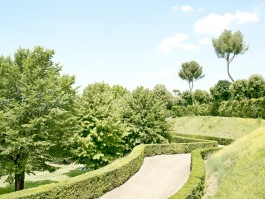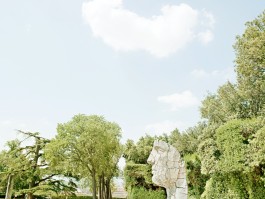Exhibition:
'The Green Hour' by Massimo Siragusa
September, 2011
The exhibition is conceived for the Civic Museums of Bassano. A historic building in the city hosts a selection of portraits of historic gardens in Italy. A journey to discover the natural and architectural beauty of the parks which have won or got to the final stage of the “the most beautiful parks in Italy ” contest sponsored by FAI.
"In Piedmont we find the Venaria Reale in Turin, one of the most significant examples of the splendor of 17th and 18th century architecture and art at European level. In Genoa the ever splendid Garden of the Villa Durazzo Pallavicini, which with its romantic park is considered one of the greatest historical gardens on a national level. In Tuscany, as well as the splendid gardens of the Villa Medicea di Castello, located in the hilly area of Florence, which today is the location of the Accademia della Crusca and considered the best-preserved example of Italian garden, there is the Boboli Garden. In Lombardy the extraordinary atmosphere of the Baroque garden of Isola Bella. Built at different times and divided into ten sloping terraces, it is embellished with pools, fountains, architectural perspectives that open against the background of the waters of Lago Maggiore. Villa D’Este in Tivoli, included in the UNESCO world heritage list, with its impressive concentration of fountains, nymphaeums, caves, water features and hydraulic music, is a repeatedly emulated model in the European gardens of mannerism and baroque. And then the Reggia di Caserta, proclaimed World Heritage by UNESCO, with its park composed of Italian and English gardens, is the largest garden in Europe over 2.5 km. long. The last stop on our journey through the Italian green wonders, is another archaeological and landscape jewel, which came back to its splendor after decades of neglect thanks to the intervention of FAI: the Garden of Kolymbetra, in the Valle dei templi in Agrigento (“Valley of Temples”). An extraordinary place for the magnificence of nature and for the richness of archaeological finds that are still coming to light."



Exhibition:
'The Green Hour' by Massimo Siragusa
September, 2011
The exhibition is conceived for the Civic Museums of Bassano. A historic building in the city hosts a selection of portraits of historic gardens in Italy. A journey to discover the natural and architectural beauty of the parks which have won or got to the final stage of the “the most beautiful parks in Italy ” contest sponsored by FAI.
"In Piedmont we find the Venaria Reale in Turin, one of the most significant examples of the splendor of 17th and 18th century architecture and art at European level. In Genoa the ever splendid Garden of the Villa Durazzo Pallavicini, which with its romantic park is considered one of the greatest historical gardens on a national level. In Tuscany, as well as the splendid gardens of the Villa Medicea di Castello, located in the hilly area of Florence, which today is the location of the Accademia della Crusca and considered the best-preserved example of Italian garden, there is the Boboli Garden. In Lombardy the extraordinary atmosphere of the Baroque garden of Isola Bella. Built at different times and divided into ten sloping terraces, it is embellished with pools, fountains, architectural perspectives that open against the background of the waters of Lago Maggiore. Villa D’Este in Tivoli, included in the UNESCO world heritage list, with its impressive concentration of fountains, nymphaeums, caves, water features and hydraulic music, is a repeatedly emulated model in the European gardens of mannerism and baroque. And then the Reggia di Caserta, proclaimed World Heritage by UNESCO, with its park composed of Italian and English gardens, is the largest garden in Europe over 2.5 km. long. The last stop on our journey through the Italian green wonders, is another archaeological and landscape jewel, which came back to its splendor after decades of neglect thanks to the intervention of FAI: the Garden of Kolymbetra, in the Valle dei templi in Agrigento (“Valley of Temples”). An extraordinary place for the magnificence of nature and for the richness of archaeological finds that are still coming to light."



